Seagate's New Barracuda 3TB (ST3000DM001) Review
by Anand Lal Shimpi on November 2, 2011 11:00 PM ESTPlatter density has been the crutch of hard drive makers in recent history. Increasing spindle speeds can reduce random access latency, but at the expense of cost and thermals. Improvements in random access performance via increasing spindle speed pale in comparison to what is possible with solid state storage, not to mention that driving motors at speeds beyond 10,000 RPM becomes quite difficult. The focus on increasing platter density is also difficult, but higher density platters can actually lead to reductions in power consumption rather than the opposite (through a reduction in the number of platters per drive). There's also the fact that if you can cram more data on a single platter there's a direct impact on sequential accesses.
Yesterday Seagate announced its transition to 1TB platters with its new 7200RPM-only Barracuda line. The move marked a significant change for Seagate as it is phasing out the Barracuda Green brand, and shifting the focus of the high-performance Barracuda XT. The Barracuda Green was a rebrand of Seagate's Barracuda LP, designed to convey the lower power consumption enabled by its 5900RPM spindle speed.
Seagate decided that the performance loss of moving to 5900RPM wasn't justified by the power savings. It believed that by introducing a more power efficient 7200RPM drive it could deliver the best of both worlds, negating the purpose of the Green line. For most desktops, Seagate has a point. The couple of watts you save by slowing down the motor aren't really realized in a system that idles at 60W and can consume over 100W under load. On the other hand, the performance drop is definitely noticeable. Hard drives have pretty bad random access performance to begin with, and slowing spindle speed isn't going to help:
| Impact of Rotational Speed on Random Access Performance - Barracuda vs Green | ||||
| 7200RPM | 5900RPM | |||
| 4KB Random Write Performance (8GB LBA) | 1.20 MB/s | 0.90 MB/s | ||
Random write performance goes up by almost 20% when you compare the Barracuda XT to the Barracuda Green. Performance in this test is mostly governed by spindle speed (and firmware), so it makes Seagate's case perfectly.
There is a segment that Seagate isn't considering as it decides to axe the Green line: the home server market. If you're doing mass archival to some external storage, random performance is likely not a big concern. Instead, all you want is cheap, low-power storage.
Come February 2012, if you want a Green drive, you'll have to shop with Western Digital.
At the other end of the spectrum, the Barracuda XT has been Seagate's performance flagship. This brand isn't going away. Instead Seagate will introduce a solid state hybrid drive under the Barracuda XT banner at some point in the future.
Everything else now falls under the bare Barracuda label. High capacity drives should become more power efficient thanks to a reduction in the number of platters, and performance should go up thanks to increased platter density.
The new 1TB platter drives all carry the M001 suffix to their model numbers:
| Seagate's 1TB-per-platter Barracuda Lineup | ||||
| Model Number | Capacity | MSRP | ||
| ST3000DM001 | 3TB | $179.99 | ||
| ST2000DM001 | 2TB | $105.99 | ||
| ST1500DM001 | 1.5TB | $83.99 | ||
| ST1000DM003 | 1TB | $71.99 | ||
Seagate sent along a new 3TB Barracuda for us to put through the paces.
The Performance
With lower power consumption in mind, Seagate is now using a 40nm dual-core LSI controller on the 1TB-platter Barracudas. The chip is physically a lot smaller than what was used in the original 3TB Barracuda XT:
Seagate continues to use 64MB of DDR2-800 as the Barracuda's DRAM cache.
The big news is obviously the platter count with the new 3TB Barracuda. While the previous drive used five platters, the new 3TB drive only uses three. It's this reduction that Seagate hopes will give it the performance and power advantages necessary to not only move the family forward, but render the outgoing Green redundant.
To find out, we threw some of our storage suite at the drive and compared it to the old Barracuda XT and Green drives. I also ripped the drive out of Seagate's 4TB GoFlex Desk enclosure, a 5-platter Barracuda XT, and included it in the comparisons.
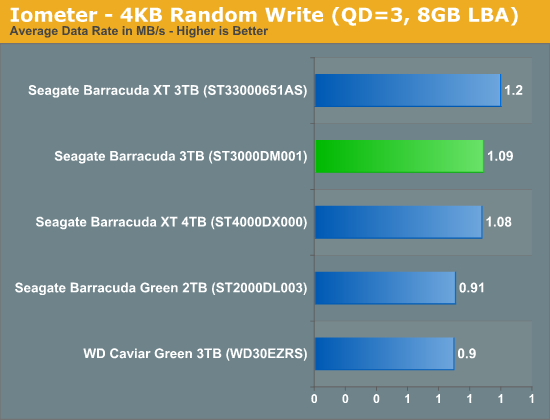
Random write performance actually dropped a bit compared to the older Barracuda XT. It's still higher than the Green drive, but it looks like Seagate has tweaked the drive's firmware a bit resulting in lower random write performance.

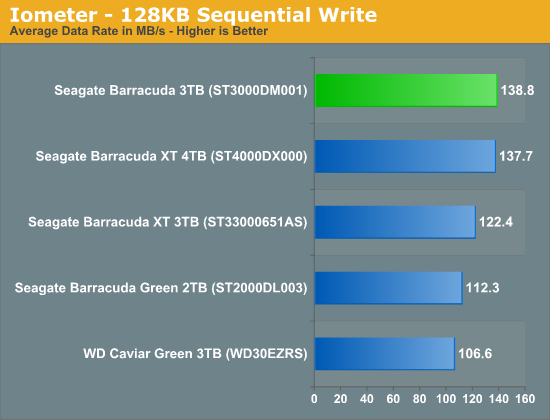
Sequential performance is up a bit over the original 3TB Barracuda XT, but about in-line with what we'd expect from a modern day high-capacity drive. Even compared to the latest 4TB Barracuda XT, we see a slight increase in performance.
Despite the sequential performance advantage, PCMark 7 showed the new Barracuda on-par with the Barracuda XT:
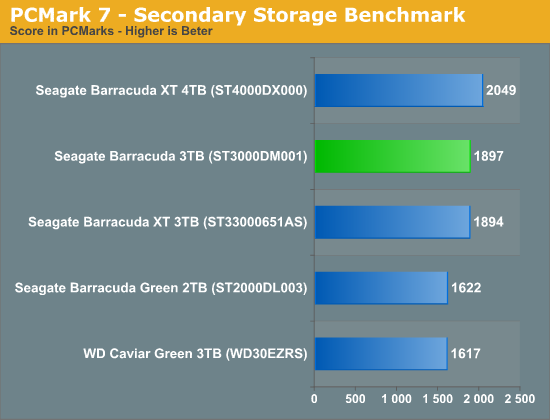
I ran the drives through our light and heavy 2011 workloads from our SSD reviews (which takes absolutely forever to run on mechanical drives) and saw some interesting data:
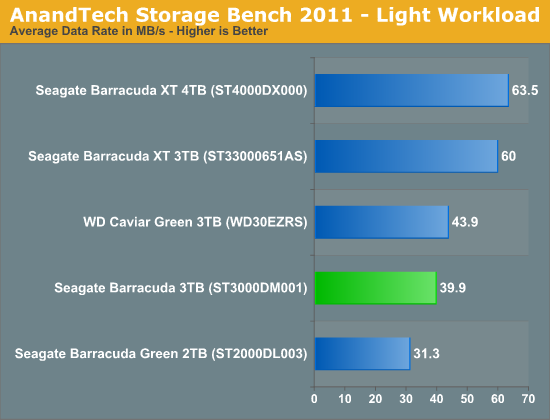

The Barracuda XT was consistently faster than the new 3TB Barracuda in our trace based benchmarks. Keep in mind that both of these tests were created on and for SSDs. Both tests involve a much heavier usage pattern and demand ultra quick response time, likely giving these hard drives an extremely strenuous workout. While the new Barracuda is faster than the outgoing Green, it seems as if the firmware isn't quite as tuned for performance as the XT. The difference does make sense, particularly if it translates into lower power usage given the new mainstream focused Barracuda lineup.
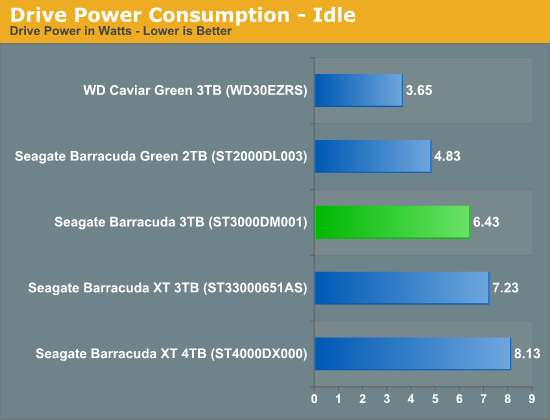
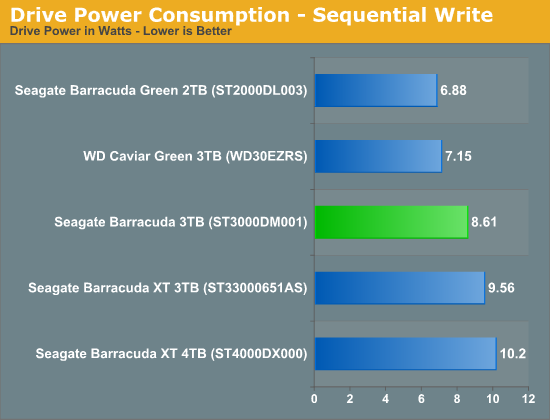
Power consumption is obviously lower than the old Barracuda XT, but still not quite as low as a 5400RPM Barracuda Green or WD Caviar Green. If you were expecting the new Barracuda to completely replace the outgoing Barracuda Green you will be disappointed. It looks like if you need a high capacity, low power 3.5" drive going forward it won't be from Seagate.
Final Words
The new 3TB Barracuda is a bit faster in sequential performance than the old Barracuda XT, at lower power consumption. In typical desktop workloads I think it's fairly safe to say that you wouldn't notice the difference between the Barracuda and Barracuda XT.
As our SSD tests showed us however, when really pushed the new Barracuda performs somewhere in between the old Green and the XT. Seagate appears to have optimized the drive's behavior for lower power rather than peak performance. If you want the absolute best performance out of a 3.5" drive, stick with the XT or wait for the new hybrid version.
Given the tremendous advantage SSDs offer over even the fastest 3.5" drives, I'm personally ok with the performance tradeoff under very heavy load so long as you've got an SSD somewhere in your system as well. I'm not sure I particularly agree with Seagate's decision to abandon the 5900RPM drive market, but thankfully there are other options available if you want a high capacity, lower power drive.




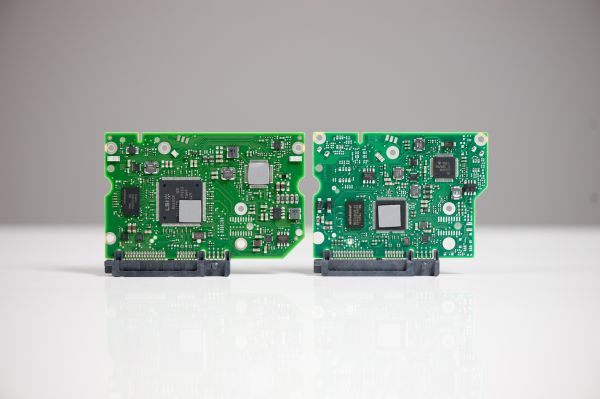
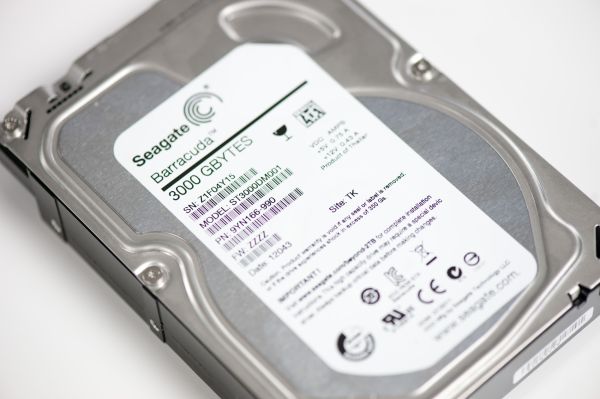








77 Comments
View All Comments
alphamm - Friday, November 4, 2011 - link
I browse through Seagate's official website, but can't find the MSRP.AFAICT, this MSRP is absolutely unbelievable. How did you get it?
Robert Kooijman - Friday, November 4, 2011 - link
From this review one can conclude the WD Caviar Green gives the best performance per Watt.A few years ago I build an AMD 780G based HTPC that has 6 SATA and 3 USB WD Caviar Green drives. Both 1 and 2 TB units. Zero problems so far: everything runs very cool and quiet. 1080p playback no problem either.
So yes, Seagate's decision to abandon low RPM drives doesn't make sense.
ikkaiteku - Friday, November 4, 2011 - link
Is Seagate using 4k sectors with their 1TB platters? Where I work, 512B vs 4KB sector size on drives makes a big difference in whether or not some machines will factory restore properly. Western Digital has been labeling *most*, but not all, of their Advanced Format drives, but Seagate is a big unknown.royalcrown - Saturday, November 5, 2011 - link
and see if it bricks...Booster - Sunday, November 6, 2011 - link
Freaken eh, LMAO! :DMain reason I went with WD instead of Seagate - reliability. WD drives up to 1TB have been rock solid for me. 2TB Greens are kinda flaky though, that's why I chose Samsung HD204UIs for 2TB Green drives, they are quite good.
Now that Samsung is out of business and WD had sunken, seems like it's a win-win for Seagate, right? Not quite so. Seagate sucks so much noone in their right mind would even consider it. For instance, they release firmware updates for their bricks on a regular basis. Haven't seen a single update for a WD drive - ever.
sduguid - Sunday, November 6, 2011 - link
I'm not sure where all of these comments about Seagate reliability are coming from. I suspect we're hearing from people who have used a few of them or have encountered a problem or two over time.I've installed thousands of Seagate drives over the years (starting with the 40GB models) and have had only a handful of returns for failure (less than 5). In two of these failures, heat was to blame due to air circulation problems.
Some of the 7200.11 drives were a bit of a fiasco and required firmware updates to work properly but those issues seemed to be under only specific and rare circumstances.
My experience with Seagate has been that their drives perform well and, more importantly, have been absolutely rock solid.
I tend to not bother posting in comments sections but thought I would counter some of the disinformation with real-world experience.
Now, if I could just actually get some more drives on a timely basis but that's a different problem. :)
Booster - Monday, November 7, 2011 - link
"I've installed thousands of Seagate drives over the years (starting with the 40GB models) and have had only a handful of returns for failure (less than 5)."You're kidding, right?
"Some of the 7200.11 drives were a bit of a fiasco and required firmware updates to work properly but those issues seemed to be under only specific and rare circumstances."
ALL of Seagate drives post 7200.10 are unreliable due to design change. 40GB 7200.7 and other drives of that era were rock solid, true. But they also had issues like oxydizing contacts IIRC.
Basically what Seagate did with 7200.11 and derivatives - they took a more advanced SCSI hard drive architecture and implemented it with low-grade consumer components. SCSI drives enjoy much higher quality heads, lower density platters to minimize read/write errors whereas consumer drives have very high read/write error rate and poor signal quality. SCSI architecture is a lot more demanding to the quality of drive components which Seagate also lowered to cut costs. So what do we have now?
Seagate drives are bricking left and right, coz that's what server drives do when they encounter errors to allow for data restoration. Seagate is working very closely with data recovery companies. In fact, their drives are designed to not only simplify recovery process, but to also ensure continuing supply of bricked drives. Seagate doesn't care if your drive bricks. After that you're supposed to pay the recovery company if the data is precious enough.
On the contrary, recovery companies don't like WD drives. They are made differently, therefore in most cases data recovery is not possible since every drive is basically unique so you can't use head assemblies from other drives or PCBs etc.
WD drives up to 1TB have been and are very reliable unlike Seagates. Post 1TB WD is also having difficulties but they are still far better than anything Seagate these days. A lot of people have encountered dead 2TB WD Greens, for instance.
sduguid - Tuesday, November 8, 2011 - link
I'm just not seeing the same thing you are. I've put a ton of 7200.12 drives in the field and have had one failure. 7200.11 also with one failure but, realistically, I used very few of them because they were replaced with the 7200.12'sfairly quickly by Seagate. I'm sure there was a reason for that.Yes, by the way, I am indeed serious about having used thousands of Seagate drives and experienced almost no failures.
However, even in the thousands, I suspect the number is statistically not significant enough to be of great use.
It is, though, somewhat better than "I had two seagate drives and both gave me problems. Seagate sucks and all their drives fail"
I think one thing everyone can agree on is that the Maxtor drives of the 40GB and 80GB era must have had a horrible failure rate :)
Booster - Tuesday, November 8, 2011 - link
"Yes, by the way, I am indeed serious about having used thousands of Seagate drives and experienced almost no failures."Excuse me, but how could you have used thousands of drives? It's physically impossible. You could've installed them and shipped those many PCs to consumers, but in actuality there'd be no way for you to observe them.
Modern Seagate drives are the worst, and it's not just my personal experience - it's a fact. Seagate took a wrong turn redesigning their consumer drives from the ground up. Now I hear rumors they've been investing heavily into the new architecture so maybe future drives won't suck as much, but that's yet to be seen.
To sum it up, 7200.11s had bricking issues. But not only that. I personally have used several 7200.11 drives and did observe instability. For instance, some of them would show increasing High Fly Writes count IIRC, and then one day would just start clicking and the PCs would freeze. But they wouldn't die surprisingly, however those aren't the drives I can trust obviously.
Newer 7200.12 generation drives tend to quickly develop reallocated sectors. I mean like all of them and it speaks for itself. Don't know if they brick just as often as 7200.11, but I'm not willing to try.
No such problems with any WD, Samsung or Hitachi drives. Now that the latter two have quit the market, I just don't see Seagate being a viable option.
JHBoricua - Thursday, November 10, 2011 - link
"Some of the 7200.11 drives were a bit of a fiasco and required firmware updates to work properly but those issues seemed to be under only specific and rare circumstances."Sure, if you consider power-cycling a computer a rare circumstance. The issues with the 7200.11 drives are well documented and it wasn't just 'some' by any small margin. Please don't try to rewrite history.
I personally had 10 out of 20 new drives fail within 2 weeks because of the issue. I'm sure the other 10 would had failed had I not updated the firmware after researching the problem. And Seagate's handling of the issue with denial after denial was idiotic. Haven't bought a drive since.
Since then, even after the update, I've had to RMA 5 of those 20 drives back to Seagate. One of the 'certified refurbished' drives I got back as replacement failed within a week. Haven't bought a Seagate drive since.